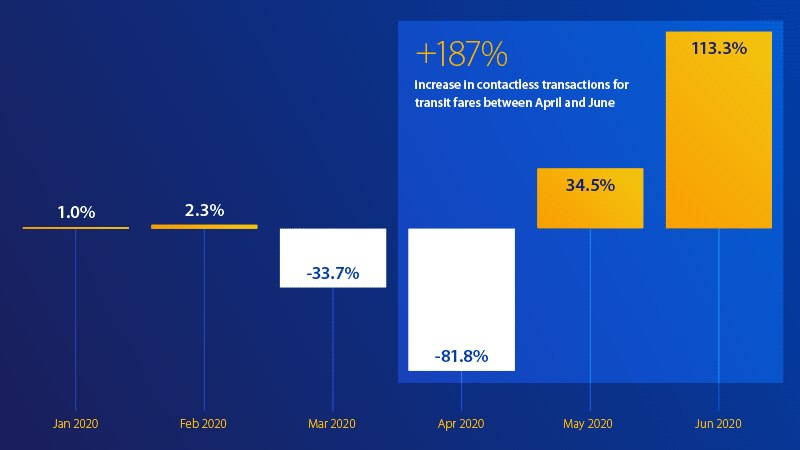Transit riders are getting on board with touchless payments
More than 500 cities are looking to Visa for tap to pay solutions as transit recovery begins; Expanded global partnership with Cubic advances the future of fare payments

COVID-19 has had a massive impact on people, communities and industries, and mass transit is no exception as daily commuters hunker down and work from home while essential workers still rely on transit systems. As cities begin opening back up at varying stages around the world, public transportation will play an essential role in economic recovery.
Pre-COVID, mass transit systems played an important role in sustainably serving many people who rely on subways, rail or buses every day. Today, with ridership starting to grow but still well off pre-COVID levels, cities and transportation systems across the globe are looking to deliver safe, reliable and efficient modes of transport. With nearly 50% of Americans saying that riding public transportation poses a high health risk due to COVID-19,1 public transport operators know the success of their systems depends on overcoming new challenges in customer safety and building confidence, in addition to convenience.
Finding opportunity during this critical setback is the subject of a new whitepaper entitled “Urban Transportation: The Connection to a Better Tomorrow,” an in-depth look at how Covid-19 has impacted our urban transit systems and how digital solutions like contactless payments can get cities safely back to work while driving economic growth. Visa provides scalable, secure and transit-ready payment solutions that can benefit the long-term health of cities. Here’s a look at one of many global transit projects that Visa has helped launch this year.
Going touchless on transit
Global Visa contactless fare payments start to rebound

As essential systems, transport operators are investing in changes to keep riders safe and confident, from precautions like mask compliance to 24/7 disinfecting efforts, and contactless or no-contact payments, which can help ease concerns and anxiety. Suddenly, contactless payments have gone from a nice-to-have for speed and convenience to a must-have for safety. No longer will transit riders have to wait in line to buy or refill a transit card, touch a payment terminal or fumble for cash. With open loop, contactless payments, riders can simply tap their contactless card or contactless-enabled mobile device at the terminal and ride.
Realizing this long-term need, cities around the world are accelerating efforts to implement touchless payments in their transit systems. After reaching a global low in April and while still below pre-COVID levels, contactless transactions for transit fares have been on the upswing for the last two months, recovering +187% by the end of June.2 Globally, Visa now has more than 500 active transit projects and has helped a number of cities launch tap to pay solutions over the course of the pandemic. Projects in Brussels, Bratislava, Bucharest, Hong Kong, Santo Domingo and Turin are now live, with more projects deploying rapidly.
Brussels transport operator STIB/MIVB recently launched contactless terminals across its entire metro network (metro, tramway and bus) — and riders are on board. In fact, since April, more than 70% of face-to-face Visa transactions in Europe were made using contactless technology. In the U.S., Caltrans, Cybersource, Monterey Salinas Transit (MST) and Visa announced that MST will be the first transit agency in the State of California to introduce a contactless payment solution. This project will not only serve to improve daily journeys for MST customers, but also establish a solution that can scale to create consistency across hundreds of transit agencies throughout California as part of the California Integrated Travel Project.
This new reality is why Visa has expanded its partnership with Cubic Transportation Systems. Visa’s trusted network and global scale combined with Cubic’s expertise as an integrator of intelligent travel solutions has advanced customer travel experiences around the globe. Visa and Cubic have launched open payment solutions in cities like London, Miami, New York, Sydney and Vancouver, making it easier to get around by tapping to pay with contactless solutions on rail and bus systems. Now, through an expanded partnership, Visa and Cubic will deliver open payment technology and mobility solutions to more people around the world:
- Cubic’s terminal and back-office solutions are now Visa Ready-certified and with Visa’s global Mass Transit Transaction model, Cubic can quickly and easily implement contactless solutions at scale. When a transit operator works with a Visa Ready partner, like Cubic, to design, develop and deploy Visa Ready-certified solutions, they can help expedite overall time-to market — an important requirement for cities looking to begin new tap to pay projects. Visa Ready for Transit now has 150 partners globally, up from 100 in October 2019.
- Cubic can access flexible, scalable, secure, and transit-compliant processing solutions as well as value-added services through Cybersource, Visa’s global payment management platform.
- Visa and Cubic will also pursue joint research and development and innovation projects to move the future of urban mobility forward.
Transit agencies are already making investments in creating systems that are more flexible, equitable and resilient and contactless payments are at the heart of this effort. The long-term health of our cities depends on the world moving around again and touchless payments is one way we get there.
1 Eno Center for Transportation, How Might Personal Transportation Behaviors Change as a Result of COVID-19, and What Does That Mean for Policy?, April 7, 2020
2 VisaNet; April–June 2020